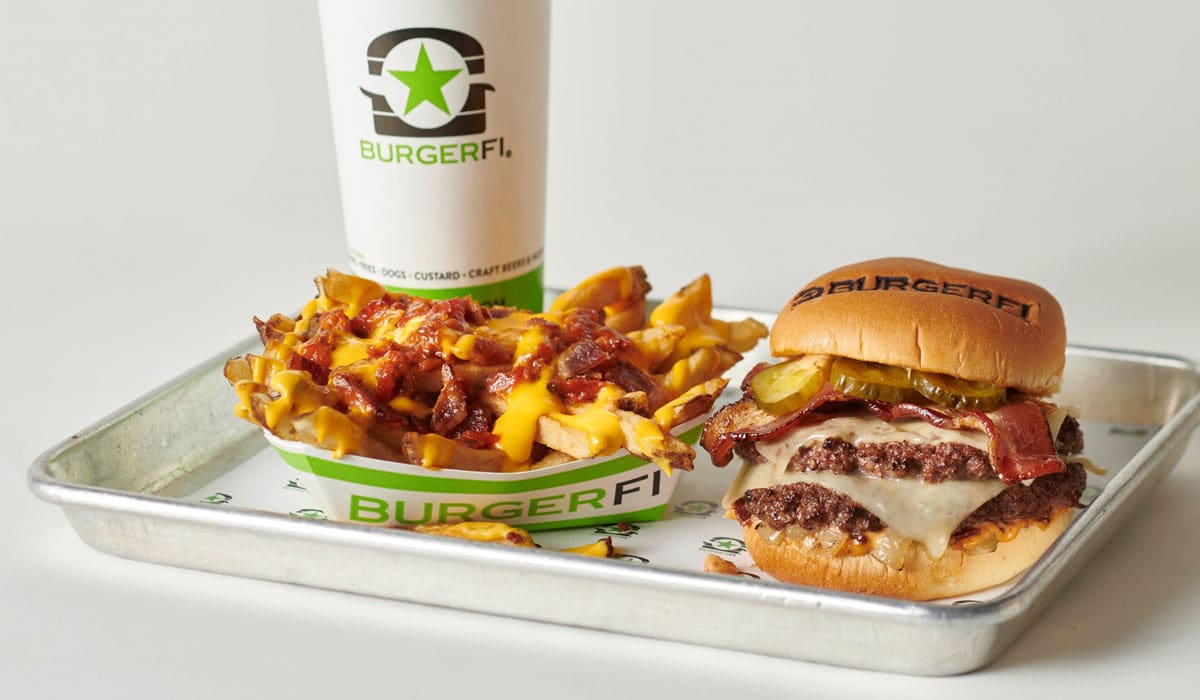BurgerFi’s unit development journey in the past couple of years hasn’t been easy.
The fast casual started 2021 expecting 25–30 stores, but because of franchisees facing COVID-related permitting and construction delays, the reality was just 16 units. This year, BurgerFi decided on a more conservative 15–20 restaurants. With six units opening from January through March, there was greater optimism around achieving 2022 guidance. CEO Ian Baines told analysts this spring BurgerFi was “well-positioned to meet our new unit opening projections.”
However, since the end of March, only two more outlets have opened, with macroeconomic issues impacting operators. As a result, projections were once again lowered, now down to 13–17 locations. The rest of the expected units this year should move into Q1 2023. BurgerFi ended Q2 with 122 restaurants—97 franchises and 25 corporate locations. In the period, the chain closed a net of two units and transferred two company-run stores to franchisees. The systemwide count is basically flat compared to when BurgerFi went public in December 2020.
READ MORE: A New, Transformational Era Begins at BurgerFi
In light of these woes, Baines said one of his focuses is finding well-capitalized franchisees with restaurant, retail, and hospitality experience. He added the pipeline is “looking strong” for 2023 and beyond. The CEO also said there’s cross-selling opportunities between BurgerFi and casual chain Anthony’s Coal Fired Pizza & Wings, which the burger chain acquired for $156.6 million in 2021. The concept has 61 corporate units, with a smaller, franchisable prototype in the works.
“Bringing these operators into our system will result in more disciplined and profitable growth over the long term,” Baines said during the company’s Q2 earnings call. “We believe both BurgerFi and Anthony’s have a long runway of organic growth ahead. We’re in discussions and negotiations with several interested parties of both brands.”
With brick-and-mortar development slowing, BurgerFi is using alternative levers to grow its footprint. In July, the chain announced intentions to expand its partnership with Gopuff’s delivery platform after a successful pilot program. BurgerFi’s menu will soon be available at more than 30 Gopuff Fresh Food Halls across the country, including new markets for the fast casual. Baines said the deal is equivalent to adding five to 10 franchise restaurants from a revenue and EBITDA perspective.
“This growth opportunity allows us to further expand and capture a new customer base while building brand awareness with no capital investment on behalf of BurgerFi,” Baines said.
BurgerFi’s same-store sales decreased 11 percent in Q2 year-over-year. The chain lapped a 44 percent increase in Q2 2021, as the brand welcomed growth coming out of the first wave of COVID. It also benefited from the successful SWAG Burger rollout last year. The company saw weakness after Mother’s Day and into June, but didn’t see trade-down in average check, which remains above $23. Instead, BurgerFi felt softness in transactions.
Some of the brighter parts of the quarter—consumer sentiment, as tracked by Chatmeter, is at an all-time high, and BurgerFi saw decreases in turnover at the restaurant level. Also, CFO Michael Rabinovitch said comps began to wane in Q3 and Q4 of 2021, meaning easier compares for the rest of this year.
For Anthony’s, same-store sales rose 3 percent year-over-year. Both chains are trailing 2019 figures by mid-single digits.
Digital mixed 33 percent at BurgerFi, while it accounted for 36 percent of sales at Anthony’s. BurgerFi has rolled out in-store kiosks to 20 of its 25 company-run locations and three franchised units. The belief is that more operators will onboard the technology over time because of its upselling and average check opportunities. The pilot led to an increase in sales, 18.5 percent average check growth, and 52 percent of guests opting into upsells. Kiosks absorbed up to 133 orders per day on average and accounted for 75 percent of total orders and 78 percent of net sales. Meanwhile, Anthony’s is testing AI phone ordering in five locations.
Although digital has proven sticky, consumers are returning to the dining room at both chains, in the mid-single-digit range.
“Our in-person dining business typically provides superior margins as we have the ability to have our guests more naturally add on items like from our bar, our appetizers, and desserts,” Baines explained.
Cost inflation, combined with soft sales, pressured BurgerFi’s profit margins in Q2. Restaurant profitability improved slightly at Anthony’s, thanks in part to the deceleration of wing prices. In the quarter, BurgerFi carried slightly under 8 percent pricing while Anthony’s had 4 percent. The company expects margin improvement in the back half of 2022 as commodity prices ease.
BurgerFi lowered its 2022 revenue guidance from $180 million to $190 million to $175 million to $180 million. Projected capital expenditure was cut from $4 million to $2 million for multiple reasons: cost of corporate units came in at a better level, the fact that BurgerFi is not opening anymore company-run stores this year, Anthony’s kitchen didn’t need equipment replacements as once thought, and the brand decided to put the upcoming Anthony’s prototype in the hands of a franchisee as opposed to making it corporately owned.
“We have two very high-quality brands that are on trend with the consumer, and we believe we’re in the early innings of our significant growth potential. I’m confident there’s still substantial for further operational progress and profitable growth here are BurgerFi,” Baines said.










